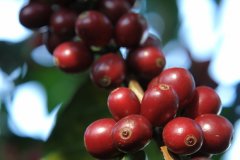An introduction to the Origin of Coffee from the Galapagos Islands in Ecuador
In 1535, the Galapagos Islands were discovered by chance by Frei Thomas de Berlanga of Spain and others. Thomas was born in 1487 on the banks of the Duro River in the Spanish province of Soria. He was the fourth bishop of Panama at that time. He was ordered to Peru. When his ship set out from Panama on February 23, under the impact of a strong current, they were carried to an unknown sea in the outer ocean. On March 10, an island in the Galapagos Islands was discovered. With only two days of fresh water left on board, the sailors landed in lifeboats and found plenty of seals, turtles, giant tortoises that could carry people and viper-like iguanas on the island, but they could not find fresh water, so they headed for another larger island more than 20 kilometers away. As there was still no wind, it took them days to get there, the water ran out quickly, and they had to starve, including the horses on board.
When Thomas and his crew landed on the island, they frantically searched for water and were so thirsty that they squeezed juice from the fat leaves of cacti to drink. Finally found water in a ravine in a rock. Thomas attributed it to God because it was Good Friday and they had celebrated Mass piously before setting out in search of water. Thomas would never have known, however, that the island they landed on was the only one in the Galapagos with plenty of fresh water, today's Saint Cristobal.
San Cristobal is a large island in the Galapagos Archipelago. At an altitude of 410 meters, there is a small lake called El Junco. The lake forms several streams flowing along the rocks and volcanic rocks on the southern slope of the island. Fresh water rich in minerals nourishes the land of San Cristobal, making the soil here always moist and fertile. It provides the most rare conditions for the growth of coffee here.
In 1875, 340 years after Frey Thomas de Berlanga discovered the island, an indigenous man named Cobos arrived on San Cristobal Island, where he established the Hasenda Coffee Plantation and planted about 100 hectares of arabic bourbon trees. Because the plantation is located between 140 meters and 275 meters above sea level, the climate is equivalent to the inland climate between 915 meters and 1830 meters, and the unique geographical conditions are suitable for the growth of super hard coffee beans (SHB) with high acidity, so this high quality coffee is settled here.
As coffee is consumed around the world and the world coffee industry moves toward mass production, San Cristobal's smaller and less reliable coffee industry is in trouble and may eventually be forced to abandon it for no profit. It wasn't until the early 1990s that the Gonzalez family bought Hassenda Coffee Plantation. The local microclimate created by the Humboldt Current, intense equatorial sunlight, and rapid temperature changes (43 ° C at sea level and 10 ° C to 16 ° C at 275 meters above sea level) provided unique favorable conditions for the Gonzalez family to expand coffee plantations. The Gonzalez family expanded their coffee plantations by reclaiming earlier lands

Important Notice :
前街咖啡 FrontStreet Coffee has moved to new addredd:
FrontStreet Coffee Address: 315,Donghua East Road,GuangZhou
Tel:020 38364473
- Prev

Coffee in Tanzani, Tanzania. The sour flavor of coffee in the Meru Mountains of Mount Kilimanjaro.
Boutique coffee (specialty coffee) is also called specialty coffee selection coffee. It refers to coffee made from a small number of raw beans with excellent taste grown in an ideal geographical environment. Depending on the special soil and climatic conditions in which they grow, they have outstanding flavor. After strict selection and classification, this kind of coffee is hard in texture, rich in taste and stylish.
- Next

Introduction of Mexican coffee beans with strong sweetness, sour taste and good aroma
High quality beans: Aldu Mara, Mexico. Taste characteristics: large granules. The best barbecue degree: medium fried or body fried. It is characterized by a smooth taste, high acidity, medium mellowness and a slightly nutty finish. Sweet, sour and bitter are neutral, with suitable sour taste, special and elegant taste. Although the professionalism of Brazilian coffee is of little value, it is very suitable for blending. Because of the coffee production
Related
- Does Rose Summer choose Blue, Green or Red? Detailed explanation of Rose Summer Coffee plots and Classification in Panamanian Jade Manor
- What is the difference between the origin, producing area, processing plant, cooperative and manor of coffee beans?
- How fine does the espresso powder fit? how to grind the espresso?
- Sca coffee roasting degree color card coffee roasting degree 8 roasting color values what do you mean?
- The practice of lattes: how to make lattes at home
- Introduction to Indonesian Fine Coffee beans-- Java Coffee producing area of Indonesian Arabica Coffee
- How much will the flavor of light and medium roasted rose summer be expressed? What baking level is rose summer suitable for?
- Introduction to the characteristics of washing, sun-drying or wet-planing coffee commonly used in Mantenin, Indonesia
- Price characteristics of Arabica Coffee Bean Starbucks introduction to Manning Coffee Bean Taste producing area Variety Manor
- What is the authentic Yega flavor? What are the flavor characteristics of the really excellent Yejasuffi coffee beans?

